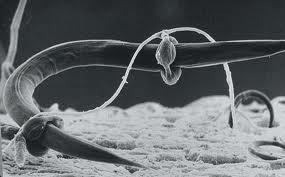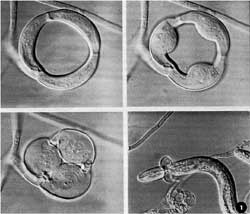Nematode trapping fungi
Introduction
Nematode trapping fungi, or “nematophageous fungi,” are carnivorous fungi that have developed methods and structures that enable them to successfully trap and consume nematodes. Nematode trapping fungi are responsible for keeping the nematode population in check and are an important part of the subsoil ecosystem. These fungi prey on nematodes and are in turn consumed by organisms on the next trophic level. Nematophageous fungi use several methods to hunt their prey. These methods include living within the nematode and slowly consuming them as well as spreading diseases through nematode populations. The fungi also live in the soil and set traps for the nematodes to squirm into.
Biological interaction
Nematophagous fungi and nematodes share a special predator-prey relationship. The nematodes, like many other soil inhabitants, secrete chemicals as they travel through the soil. Fungi that prey upon these nematodes have found a way to detect and respond to the existence of these chemicals.The fungi have also developed many sophisticated ways to trap the nematodes by attacking from both outside and within the nematode.
Detecting the Nematodes
In order to effectively hunt its prey, many species of fungi have developed the ability to detect some of the chemicals that nematodes use to communicate and grow. These chemicals are detected when the nematodes wander too close to the fungus. And if the fungus is in need of nutrients that are not provided in its diet, it will create traps in the area in which it detected the chemicals and thus effectively hunting its prey.
Secretion by Nematodes
Nematodes produce a highly conserved family of small molecules called ascarosides.These small molecules are special to the nematodes and the fungi are able to detect them. Different species of nematode produce different varieties of ascarosides.
Detection by Fungi
Traps to ensnare the nematode are created when these ascarosides are detected.
Trapping the Nematodes
Hyphal Rings
One method used by fungi to trap nematodes is the fungal ring. The fungus produces hyphae that end in an open constricting loop. When a nematode swims through this loop, the loop suddenly fills with water. This sudden change in the physiology of the loop causes the diameter of the inside of the loop to narrow and in turn constricts around the nematode. Within 24 hours, hyphae form from within the loop and penetrate the nematode as it begins to digest it.
Adhesive Hyphae
Nematotoxic Compounds
Niche
Describe the physical, chemical, or spatial characteristics of the niche where we might find this interaction, using as many sections/subsections as you require. Look at other topics available in MicrobeWiki. Create links where relevant.
Subsection 1
Subsection 1a
Subsection 1b
Subsection 2
Microbial processes
What microbial processes are important for this microbial interaction? Does this microbial interaction have some ecosystem-level effects? Does this interaction affect the environment in any way? Describe critical microbial processes or activities that are important in this interaction, adding sections/subsections as needed. Look at other topics in MicrobeWiki. Are some of these processes already described? Create links where relevant.
Subsection 1
Subsection 1a
Subsection 1b
Subsection 2
Key Microorganisms
What specific kinds of microbes are typically involved in this interaction? Or associated with important processes? Describe key groups (genera, species) of microbes that we find in this environment, and any special adaptations they may have evolved to survive in this environment. List examples of specific microbes that represent key groups or are associated with important processes found in this environment. Add sections/subsections as needed. Look at other microbe listings in MicrobeWiki. Are some of the groups of microbes from your environment already described? Create links to other MicrobeWiki pages where possible.
Subsection 1
Subsection 1a
Subsection 1b
Subsection 2
Current Research
Enter summaries of recent research here--at least three required
References
Loynachan, T. 2007.
Edited by Brad Launer, a student of Angela Kent at the University of Illinois at Urbana-Champaign.


